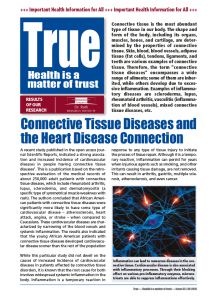- Have any questions? Contact us!
- info@dr-rath-foundation.org

Micronutrients Support Blood Sugar Metabolism
October 4, 2017
Micronutrients Support the Function of Heart Muscle
October 4, 2017Connective Tissue Diseases and the Heart Disease Connection

 Connective tissue is the most abundant type of tissue in our body. The shape and form of the body, including its organs, muscles, bones, and cartilage, are determined by the properties of connective tissue. Skin, blood, blood vessels, adipose tissue (fat cells), tendons, ligaments, and teeth are various examples of connective tissue. Therefore, the term “connective tissue diseases” encompasses a wide range of ailments; some of them are inherited, while others develop due to excessive inflammation. Examples of inflammatory diseases are scleroderma, lupus, rheumatoid arthritis, vasculitis (inflammation of blood vessels), mixed connective tissue diseases, etc.
Connective tissue is the most abundant type of tissue in our body. The shape and form of the body, including its organs, muscles, bones, and cartilage, are determined by the properties of connective tissue. Skin, blood, blood vessels, adipose tissue (fat cells), tendons, ligaments, and teeth are various examples of connective tissue. Therefore, the term “connective tissue diseases” encompasses a wide range of ailments; some of them are inherited, while others develop due to excessive inflammation. Examples of inflammatory diseases are scleroderma, lupus, rheumatoid arthritis, vasculitis (inflammation of blood vessels), mixed connective tissue diseases, etc.
A recent study published in the open access journal Scientific Reports, indicated a strong association and increased incidence of cardiovascular diseases in people having connective tissue diseases¹. This is a publication based on the retrospective evaluation of the medical records of about 250,000 adult patients with connective tissue diseases, which include rheumatoid arthritis, lupus, scleroderma, and dermatomyositis (a specific type of symmetrical muscle weakness with rash). The authors concluded that African American patients with connective tissue diseases were significantly more likely to have some type of cardiovascular disease – atherosclerosis, heart attack, angina, or stroke – when compared to Caucasians. These cardiovascular diseases are characterized by narrowing of the blood vessels and systemic inflammation. The results also indicated that the young African American patients with connective tissue diseases developed cardiovascular disease sooner than the rest of the population.
While this particular study did not dwell on the causes of increased incidence of cardiovascular diseases in patients affected by connective tissue disorders, it is known that the root cause for both involves widespread systemic inflammation in the body. Inflammation is a temporary reaction in response to any type of tissue injury to initiate the process of tissue repair. Although it is a temporary reaction, inflammation can persist for years when injurious agents such as smoking, and other irritants causing tissue damage, are not removed. This can result in arthritis, gastritis, multiple sclerosis, atherosclerosis, and even cancer.
We have documented the anti-inflammatory effects of a micronutrient mixture composed of vitamin C, the amino acids lysine and proline, and green tea extract, in human aortic smooth muscle cells². These findings are important in relation to inflammation processes associated with the progression of atherosclerosis. In another study, we have shown that a mixture of selected micronutrients in combination with citrus flavonoids and quercetin worked synergistically and significantly reduced the markers of inflammation in the blood³. Additionally, the results have shown that micronutrient supplementation provided better protection against inflammation than common painkillers – ibuprofen – and it reduced the levels of Cox2 enzymes and other inflammatory markers. It is important to note that pharmaceutical Cox2 inhibitors, such as Vioxx, carry a risk of life threatening side effects and were removed from the market a few years ago.
Currently, other than artificial suppression of symptoms, there are no satisfactory cures available for inflammation, connective tissue diseases, or cardiovascular diseases. We have proven that micronutrients are safe, effective, and provide additional health benefits.



